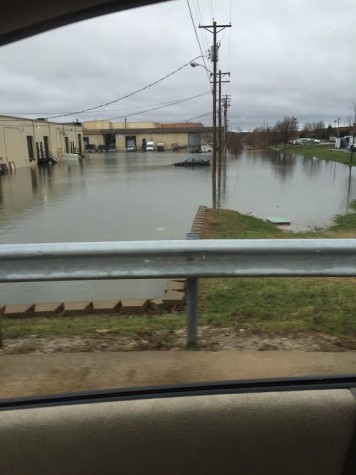The Great Mississippi Flood of 1927. The Great Flood of 1993. It seems history has repeated itself in the most destructive way possible, greeting Missouri and neighboring states with a torrential downpour spanning from Dec. 26 to Dec. 28 that led to the flooding of residential and commercial areas alike.
It was only 23 years ago that the Midwest was hit by its last large-scale flood, the $15 million in damages spanning across Illinois, Iowa, Kansas, Minnesota, Missouri, Nebraska, North Dakota, South Dakota and Wisconsin.
And before this came the Great Mississippi Flood of 1927, triggered by a sudden 11 inches of rain.
“Fifty flood deaths occurred, and…hundreds of levees failed along the Mississippi and Missouri Rivers. The magnitude and severity of this flood event was simply over-whelming, and it ranks as one of the greatest natural disasters ever to hit the United States,” a report by the National Weather Service read following the 1993 catastrophe. “Approximately 600 river forecast points in the Midwestern United States were above flood stage at the same time.”
“The Mississippi River flood of 1927 inundated roughly 27,000 square miles of land and displaced some 700,000 persons. Property damage was estimated at $400 million, and 246 people died in the flood waters,” the Missouri Department of Archives and History’s website stated after the flood’s occurrence.
In the case of both past floods and the 2015 flood, the breaking of multiple levees led to the quick, unstoppable flow of water from overfilled rivers and tributaries. The Great Flood of 1993 is additionally partially attributed to the now-imprisoned James Scott after he was convicted of purposely breaking a levee in Illinois by removing sandbags. For the 2015 and 1927 floods, levee damage was caused by rainfall alone.
After a 100-foot section of the Monarch-Chesterfield Levee was broken in 1993, eight feet of water surged into the Chesterfield Valley and left a historic mark on local businesses and homes that is memorialized today through lines drawn and painted on buildings and signs throughout the area.
“The bottom of this plaque indicates the high water mark of the Great Flood of 1993. On [August 1, 1993], the Mississippi River reached 49.58 feet, the highest level ever recorded in the city of St. Louis,” a plaque affixed to the steps of the St. Louis arch reads.
Since then, the earthen levee has been built up from 3 feet to 6 feet, widened, circled by monitored wetlands and outfitted with additional flood gates.
“Although several dozen businesses abandoned the area for higher ground after the devastating flood, others chose to remain,” Hanson Inc.’s project gallery reads. “The city of Chesterfield created a tax-increment financing district to rebuild the levee and revitalize the area. As a result, Chesterfield Valley has become one of the region’s hottest retail markets, and its success has spurred other cities to develop their flood plains.”
Now standing as a 500-year levee, the project has undergone major construction to be officially upgraded from a 100-year levee as it was in 1993. Hanson Inc. has additional plans to build flood walls around the levee.
Missouri governor Jay Nixon called in the National Guard after the events of 2015’s flood, providing security in evacuated areas, directing traffic and generally providing aid, the guard was also present during 1993’s flood.
“I mean, 13 feet above flood level is one thing. The four feet above all-time historic levels puts us in a situation where we’re evacuating folks. It’s why I called the National Guard, it’s why we’ve got a state of emergency, it’s why we’re working with the Red Cross. It’s cold out there too,” Nixon said in a phone interview with CNN as the 2015 flood progressed. “This is dangerous, we’ve got water moving.”
Flooding is nothing new to St. Louis, and the extensive cleanup of debris and the thousands of damaged buildings after the area’s most recent flood has only just begun.
Based on initial estimates, more than 7,000 structures in #STL region were damaged by flooding, creating up to a half million tons of debris
— Governor Jay Nixon (@GovJayNixon) January 5, 2016
Twenty-eight lives were lost to the rising water as cars were swept off the road, individuals were pulled undercurrent and electrical lines were downed. At least five of the victims have been confirmed as international soldiers.
“Historic [and] heartbreaking losses,” Nixon said in an additional tweet. “We’ll be [with] these Missourians every step of the way.”




![Smiling in a sea of Longhorns, Fox 2 reporter Ty Hawkins joins junior Darren Young during the morning Oct. 3 pep rally. The last time West was featured in this segment was 2011. “[I hope people see this and think] if you come to [Parkway] West, you will have the time of your life because there are so many fun activities to do that make it feel like you belong here. I was surprised so many people attended, but it was a lot of fun,” Young said.](https://pwestpathfinder.com/wp-content/uploads/2025/10/Edited2-1200x798.jpg)
![West High seniors and families listen as a representative of The Scholarship Foundation of St. Louis, Teresa Steinkamp, leads a Free Application for Federal Student Aid (FAFSA) workshop. This session, held in the library, provided guidance on financial aid, scholarships and student loan options. “This event is very beneficial for any seniors who are applying to or considering applying to colleges after high school [because] the cost of college is on the rise for seniors and parents,” college and career counselor Chris Lorenz said.](https://pwestpathfinder.com/wp-content/uploads/2025/09/DSC_4478-1200x778.jpg)
![Senior Kamori Berry walks across the field during halftime at the Homecoming football game on Sept. 12. During the pep assembly earlier that day, she was pronounced Homecoming Queen. “I thought it was nice that the crowd [started] cheering right away. I know [my friends] were really excited for me, and my family was happy because typically non-white people don't win,” Berry said.](https://pwestpathfinder.com/wp-content/uploads/2025/09/DSC7046-Enhanced-NR-1200x798.jpg)



![Pitching the ball on Apr. 14, senior Henry Wild and his team play against Belleville East. Wild was named scholar athlete of the year by St. Louis Post-Dispatch after maintaining a high cumulative GPA and staying involved with athletics for all of high school. “It’s an amazing honor. I feel very blessed to have the opportunity to represent my school [and] what [it] stands for,” Wild said.](https://pwestpathfinder.com/wp-content/uploads/2025/05/unnamed-6-1200x714.jpg)
![The Glory of Missouri award recipients stand with their certificates after finding out which virtue they were chosen to represent. When discovering their virtues, some recipients were met with contented confirmation, while others, complete surprise. “I was not at all surprised to get Truth. I discussed that with some of the other people who were getting the awards as well, and that came up as something I might get. Being in journalism, [Fellowship of Christian Athletes and] Speech and Debate, there's a culture of really caring about truth as a principle that I've tried to contribute to as well. I was very glad; [Truth] was a great one to get,” senior Will Gonsior said.](https://pwestpathfinder.com/wp-content/uploads/2025/04/Group-Glory-of-Missouri.jpg)

![Focused on providing exceptional service, sophomore Darsh Mahapatra carefully cleans the door of a customer’s car. Mahapatra has always believed his customers deserve nothing less than the best. “[If] they’re trusting us with their car and our service, then I am convinced that they deserve our 100 percent effort and beyond,” Mahapatra said.](https://pwestpathfinder.com/wp-content/uploads/2025/10/DSC_0018-1200x800.jpg)
![Sophomore Aleix Pi de Cabanyes Navarro (left) finishes up a soccer game while junior Ava Muench (right) warms up for cross country practice. The two came to Parkway West High School as exchange students for the 2025-2026 school year. “The goal for the [exchange] program is to provide opportunities for both Parkway students and our international exchange students to learn about other cultures, build connections and become confident, capable, curious and caring — Parkway’s Four C’s — in the process,” Exchange Program Lead Lauren Farrelly said.](https://pwestpathfinder.com/wp-content/uploads/2025/10/Feature-Photo-1200x800.png)
![Leaning on the podium, superintendent Melissa Schneider speaks to Parkway journalism students during a press conference. Schneider joined Parkway in July after working in the Thompson School District in Colorado. “My plan [to bond with students] is to get things on my calendar as much as possible. For example, being in [classes] is very special to me. I am trying to be opportunistic [meeting] kids [and] being in [the school] buildings. I have all the sports schedules and the fine arts schedules on my calendar, so that when I'm available, I can get to them,” Schneider said.](https://pwestpathfinder.com/wp-content/uploads/2025/09/IMG_5425-1200x943.jpeg)
![Gazing across the stage, sophomore Alexis Monteleone performs in the school theater. The Monteleone family’s band “Monte and the Machine” has been releasing music since 2012, but Alexis started her own solo career in 2024 with the release of her first single, Crying Skies. “My whole family is very musical, [and I especially] love writing [songs with them],” Monteleone said.](https://pwestpathfinder.com/wp-content/uploads/2025/09/DSC7463-1200x798.jpg)
![Leaping through the air, senior Tyler Watts celebrates his first goal of the season, which put the Longhorns up 1-0 against the Lafayette Lancers. Watts decided to play soccer for West for his last year of high school and secured a spot on the varsity roster. “[Playing soccer for West] is something I had always dreamed of, but hadn’t really had a good opportunity to do until now. It’s [really] fun being out [on the field], and I’m glad I decided to join the team. It’s just all about having fun with the boys and enjoying what time we have left together,” Watts said.](https://pwestpathfinder.com/wp-content/uploads/2025/09/DSC_1951-1200x855.jpg)

![Junior Fiona Dye lifts weights in Strength and Conditioning. Now that the Trump administration has instituted policies such as AI deregulation, tariffs and university funding freezes, women may have to work twice as hard to get half as far. "[Trump] wants America to be more divided; he wants to inspire hatred in people,” feminist club member and junior Clara Lazarini said.](https://pwestpathfinder.com/wp-content/uploads/2025/05/Flag.png)
![As the Trump administration cracks down on immigration, it scapegoats many immigrants for the United States’ plights, precipitating a possible genocide. Sophomore Annabella Whiteley moved from the United Kingdom when she was eight. “It’s pretty scary because I’m on a visa. When my visa expires next year, I’m not sure what’s going to happen, especially with [immigration] policies up in the air, so it is a concern for my family,” Whiteley said.](https://pwestpathfinder.com/wp-content/uploads/2025/05/DSC_0077-7copy.jpg)
![Shifting global trade, President Donald Trump’s tariffs are raising concerns about economic stability for the U.S. and other countries alike. “[The tariffs are] going to pose a distinct challenge to the U.S. economy and a challenge to the global economy on the whole because it's going to greatly upset who trades with who and where resources and products are going to come from,” social studies teacher Melvin Trotier said.](https://pwestpathfinder.com/wp-content/uploads/2025/05/MDB_3456-1200x800.jpg)
![Red, white and blue, the American flag holds the values of our democracy. The fight that we once endured has returned, as student journalists and senior correspondents across the country are losing their voices due to government control. “[Are] the White House and [the] government limiting free speech [and] freedom of the press? Yes [they are],” chief communications officer of the Parkway School District and former journalist Elisa Tomich said.](https://pwestpathfinder.com/wp-content/uploads/2025/03/Untitled-design-14.jpg)
